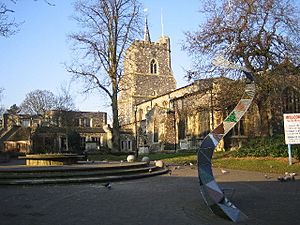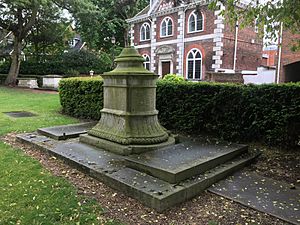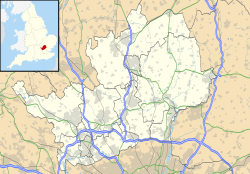St Mary's Church, Watford facts for kids
Quick facts for kids St Mary's Watford |
|
|---|---|

View of St Mary's from the East
|
|
| 51°39′16″N 0°23′45″W / 51.654563°N 0.395923°W | |
| OS grid reference | TQ1196 |
| Location | Church Street, Watford WD18 0EG |
| Country | England |
| Denomination | Church of England |
| Churchmanship | Evangelical |
| Website | stmaryswatford.org |
| History | |
| Founded | 1100 or later |
| Events | 1871 renovated |
| Architecture | |
| Heritage designation | Grade I listed |
| Style | Early English Gothic |
| Specifications | |
| Spire height | 33 metres (108 ft) (including 'spike') |
| Bells | 10 (1704, 1919 & 1946) |
| Tenor bell weight | 1,237 kilograms (2,727 lb) |
| Administration | |
| Parish | Watford |
| Diocese | Diocese of St Albans |
| Province | Province of Canterbury |
St Mary's Watford is a Church of England church located in Watford, Hertfordshire, England. It's an active church right in the town centre, about 25 kilometres (15 miles) outside London. St Mary's is the main church for Watford and is part of the Anglican Diocese of St Albans. People believe the church is at least 800 years old. Inside, you can find graves of important local families and some amazing sculptures from the Elizabethan era and Jacobean era (times when Queen Elizabeth I and King James I ruled).
Contents
History of St Mary's Church
We don't have exact records of when St Mary's Church first started. The oldest church records we have are from 1539, but the church is much older than that. Most of the building you see today was built in the 1400s. However, some of the oldest parts are thought to be from around 1230.
During repairs in 1871, workers found stones from the 1100s built into the church. They even found part of a 12th-century baptismal font (a bowl used for baptisms) in the tower walls. Finding these old stones suggests that St Mary's Church was probably built around the same time Watford Market was given permission to start. This happened during the time of either King Henry I (1100–1135) or King Henry II (1154–1189).
One of the past vicars (church leaders) of St Mary's was William Capel. He was the son of an important noble, the 3rd Earl of Essex, and was also a well-known amateur cricket player.
On July 18, 1909, King Edward VII attended a church service here. He visited while staying with the Earl of Clarendon at a nearby estate called The Grove. The king entered the church through a door that is now known as the Edward VII door.
The patron (the person or family who supported the church) was the Earl of Essex.
Architecture and Memorials
St Mary's Church is built from stone and covered with flint (a type of hard stone). It has a wide clock tower at the west end, which is common for churches in Hertfordshire. The top of the tower has crenelations, which look like the battlements on a castle.
The main part of the church, called the nave, has six sections. On either side of the nave are long hallways called aisles. These aisles have piers (large columns) that are shaped like octagons. Above these piers, there's a row of windows called a clerestory, which lets light into the nave. The nave has a wooden roof with beams that rest on carved angels.
From the outside, St Mary's mostly looks like a 15th-century building. The tower, the outer walls of the aisles, the clerestory, the nave roof, and a chapel on the south side of the chancel (the area around the altar) all date from this period. The chancel itself is the oldest part of the church. Its archway and a special basin called a piscina are from the 13th century.
Around the late 1200s, a chapel was added to the south aisle. This chapel was dedicated to St Katherine. It was built by John Heydon, who owned The Grove Estate in Watford, so it was also known as the Heydon Chapel. Later, this chapel was used as a room for the church organ.
The pulpit (where the preacher stands) was made in 1714 by Richard Bull. Inside the church, there are many marble memorials to local people from the 1600s and 1700s. One special memorial is a white marble tablet in the Choristers' Vestry. It remembers Robert Clutterbuck, who wrote a famous history book about Hertfordshire. Many members of the Clutterbuck family are buried in a vault (an underground room) beneath it.
Restoration Works
The inside of the church was repaired in 1848. Then, in 1871, the church had a big restoration project led by architect John Thomas Christopher. During these repairs, the old plaster on the outside was removed and replaced with knapped flint (flint stones that have been shaped). Battlements were added to the tower, the south aisle walls were rebuilt, and new roofs were put on. The 15th-century south chapel was also changed.
New things were added inside the church at this time. These included a fancy stone baptismal font carved by James Forsyth and a stone reredos (a screen or decoration behind the altar) carved by E Renversey. Beautiful stained glass windows were installed by the company Heaton, Butler and Bayne. The oak pews (long wooden benches) put in at this time were especially famous for their detailed carvings.
Another restoration project happened in 1987. This included fixing the roof and the organ. In 1979, a new church hall, shaped like an octagon, was built on the south side of the church.
21st-century Refurbishment
In 2014, plans were announced for more updates to the church's interior. This included putting in new flooring, adding clear plate glass screens inside, and removing the old oak pews to replace them with modern upholstered chairs. This plan was approved by the Church of England's court, but some groups who wanted to protect old buildings, like the Victorian Society and Historic England, disagreed with it. Watford Borough Council also objected to the changes.
The refurbishment work took place from late 2017 to March 2019. The pews in the nave were taken out, and their carved end panels were reused as decoration inside the church. While removing the old floor, workers found 13 hidden burial vaults. These had to be carefully recorded and protected before the new underfloor heating and stone floor could be installed.
Some memorials survived the Victorian restoration. One is a large metal plaque, called a monumental brass, for Hugh de Holes (who died in 1415) and his wife. The brass shows de Holes wearing the special clothes of a judge.
On the south wall of the nave, there's a white marble tablet dedicated to Jane Bell. Her husband, John Bell, was a respected person. The very long message on her memorial was written by the famous writer Dr. Samuel Johnson. There are also other smaller memorials, including one for Anne Derne (who died in 1790), made by J. Golde.
The pipe organ in the church was installed in 1935 and was built by the company J. W. Walker & Sons Ltd.
Today, St Mary's is a Grade I listed building. This means it's considered a very important historical building that needs to be protected.
The Essex Chapel

St Mary's Watford was the church for the nearby Cassiobury Estate. Because of this, it became a burial place for important noble families from Watford. The chapel on the north side of the chancel is known as the Essex Chapel or the Morison Chapel. It holds the burials of the Earls of Essex and members of the Morison and Capel families.
This chapel was started in 1595 by Bridget, Dowager Countess of Bedford. She was the widow of Sir Richard Morison and Francis Russell, 2nd Earl of Bedford. The chapel is famous for its amazing memorials. Two large table tombs (tombs shaped like tables) used to be in the middle of the chapel. One was for Countess Bridget (who died in 1600) and the other for Lady Dame Elizabeth Russell (who died in 1611). These tombs were moved in 1907 to another family chapel in Chenies, Buckinghamshire. In 1916, the chapel was restored by Adele, Dowager Countess of Essex, in memory of her husband, George Capell, 7th Earl of Essex.
The most impressive memorials in the chapel are two large wall monuments made by the sculptor Nicholas Stone. A famous expert, Pevsner, called them "the chief glory of Watford Church."
On one side is the tomb of the politician Sir Charles Morison (1549–1599). He was the son of Dowager Countess Bridget. The tomb shows a white marble statue of Sir Charles lying down. He has a Van Dyke beard and is wearing armour and a large Elizabethan ruff (a pleated collar) around his neck. Sir Charles is surrounded by a fancy archway supported by two colourful marble pillars. There are also figures of his son and daughter kneeling at each end. A long Latin message describes his many good qualities and says he founded the chapel.
Opposite this is the tomb of his son, Sir Charles Morrison, 1st Baronet, who died in 1628. It's designed in a similar style, with statues of Sir Charles and his wife Mary. Sir Charles is shown wearing armour, resting on his elbow, with a skull under his hand. He is placed above the statue of his wife, who is lying on a cushion, wearing a richly embroidered dress and a ruff. The statues are inside a four-poster canopy. Below them, at each end, are kneeling figures of a young man, a boy, and a young lady. A Latin message at the bottom explains how their daughter, Elizabeth, married Arthur Capell, 1st Baron Capell of Hadham in 1627.
Other memorials in the chapel include one for George Capell-Coningsby, 5th Earl of Essex (1757–1839), which has a beautifully carved family coat of arms. There's also a memorial for his daughter Harriet, who died in 1837 at age 29. You can also find a simple marble memorial for Arthur Algernon Capell, 6th Earl of Essex (1803–1892) and one for his son, Arthur de Vere Capell, Viscount Malden (1826–1879). Another memorial is for Caroline Janetta, wife of the 6th Earl, who died in 1862. There's also a brass plaque for Randolph, the second son of Janetta and the 6th Earl. He served in the navy during the Crimean War and died in Rio de Janeiro in 1857, at age 25.
A smaller wall memorial shows a female figure kneeling between two marble pillars. This has been identified as Lady Dorothy Morrison (who died in 1618), the wife of Sir Charles Morrison the elder.
The Churchyard

In St Mary's churchyard (the graveyard around the church), you can find several old tombs from the 1700s and 1800s. These are called neoclassical chest tombs and are also listed as heritage sites. They hold the burials of important Watford residents who helped the town grow into an industrial centre.
Some of these tombs include:
- The tomb of James Dundas, a ship's captain for the East India Company.
- The tomb of John Dyson, who started the Watford brewery that later became Benskins Brewery.
- The tomb of Elizabeth and Ralph Morrison, who died in 1772 and 1780 (they are not related to the Morrisons of Cassiobury House).
- The Clutterbuck Tomb, which marks the burials of the Clutterbuck family. This was a large family from Hertfordshire, and their descendants included Robert Clutterbuck, the famous historian who wrote a history book about Hertfordshire in 1815.
- The grave of George Edward Doney (who died in 1809). He was a freed slave from Virginia in America. He had been taken from the Gambia in Africa as a baby. After he became free, he worked as a servant at Cassiobury House for the 5th Earl of Essex.
There's a unique story about a grave known as the Fig Tree Tomb. The person buried there was said to be an atheist (someone who doesn't believe in God). According to the story, they said on their deathbed that if there was a God, a fig tree should grow out of their heart. After they died in the early 1800s, a fig tree did indeed grow out of this tomb for many years, breaking through the stone. However, it died during the very cold winter of 1962-63.
Location
St Mary's Church is located on Watford High Street. It is across from the Watford Intu shopping Centre and about 0.2 miles (320 metres) from Watford High Street railway station.





